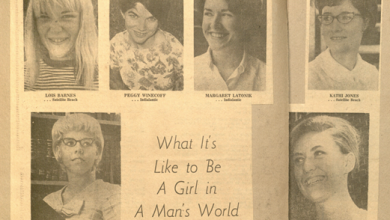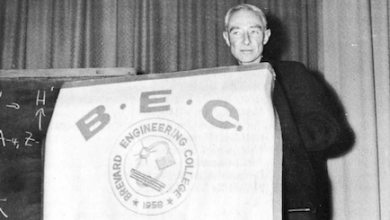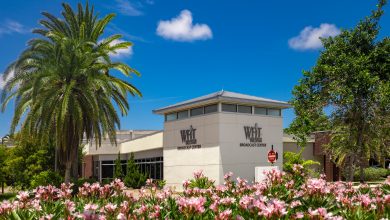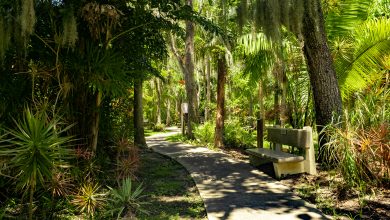Secret History: The Mystery of the Missing Mammoth and the Dead Woman
Dateline: Florida Tech Botanical Garden, circa 25,000-10,000 BCE


Three days after Christmas in 1925, James Gidley, curator of the Smithsonian’s Natural History Museum, read a paper at the American Paleontological Society’s annual meeting in New Haven, Connecticut, describing an astonishing array of discoveries. In early July, Gidley and his friend Frederic Loomis, had conducted a joint Smithsonian-Amherst College expedition to Melbourne, Florida. Gidley and Loomis focused their attention on three sites in what are now Florida Tech’s Botanical Garden and the Crane Creek Reserve Golf Course. During their time in Melbourne, Loomis, an archaeology and geology professor at Amherst College, and Gidley had come upon the crushed skull of an adult female which Gidley “suggested had been stepped on by a mastodon or mammoth. ”(Stewart 1946). The skull proved to be a key element in a series of remarkable discoveries made along the edge of what Loomis described as “a small stream, winding through a hammock.” Gidley and Loomis’ findings included along with the woman’s skull and the bones of numerous megafaunas. Two years earlier, at the same site Loomis had found a “rough flint implement shaped like an arrowhead” buried in the ribcage of one of the massive beasts. (Loomis 1924) Gidley believed that the Smithsonian-Amherst expedition and established that human beings were present in Florida in the late Pleistocene era.

Normally, meetings of the Paleontological Society are staid affairs. By happen chance, however, rumors of Gidley’s claim reached members of the American Anthropological Association, who were holding their annual meeting a few blocks from the paleontologists’ meeting. Gidley’s assertions provoked a heated controversy between the anthropologists and paleontologists that raged for more than a generation. At the center of the dispute was Gidley and Loomis’ contention that the human remains they had found in Melbourne conclusively proved human beings and the megafauna of the late Pleistocene Era had coexisted 15,000-25,000 years ago in Florida. According to a contemporary account, the anthropologists, led by Aleš Hrdlička, stormed into the Paleontological Society meeting, arguing that Gidley had erred in his estimate of the antiquity of the human remains. Fortunately, no skulls were crushed during the heated exchanges that followed Gidley’s paper. The Paleontological Society’s secretary noted that the dispute between the ethnologists and archaeologists, though “spirited,” was conducted with “rather more dignity than had [been] anticipated.”(Stewart 1946)
Serendipity often plays a critical role in human affairs. The paleontologists’ interest in Melbourne was sparked when Gidley received a letter in 1922 from C.P. Singleton, a Brevard resident, describing a large collection of mammalian bones in Melbourne. Singleton reported that workers had discovered a rich deposit of bones located along the stream bed near where Singleton planned to plant a citrus grove. Shortly after Gidley received Singleton’s letter, Loomis and his family passed through Washington on their way to Florida for a holiday. Gidley convinced Loomis to change his travel plans. Later, Loomis recalled that he had planned to spend the winter “enjoy[ing] the orange and grape fruit groves, and truck farms and the sea beaches.”(Giller 2017) With Gidley’s encouragement, Loomis went to Melbourne where he spent six weeks exploring the low, flat area adjacent to the stream bed and the near-by hammock.
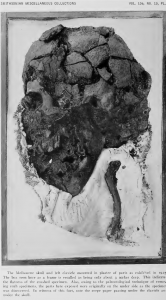
Loomis characterized the Melbourne site as one of the most remarkable Pleistocene sites in north America. Gidley was so impressed with what Loomis had unearthed that he organized a joint Smithsonian-Amherst archaeological expedition to Melbourne eighteen months later in July 1925. That summer he and Loomis discovered the woman’s crushed skull. Gidley considered the Melbourne site so important that he would return to the Melbourne in 1926, 1928, 1929, and 1930. Sadly, his untimely death in 1931 occurred before he was able to publish his findings.

Loomis provided an intriguing account of the initial six weeks that he spent in Melbourne in his “Artifacts associated with the remains of a Columbian elephant at Melbourne, Florida.”(Loomis 1924) Loomis who had done extensive work in Patagonia and the American Southwest considered the time he spent in Florida as some of the most exciting, productive weeks in his career as a paleontologist. He described his excitement in the discovery of the skeleton of an Elephas columbi (mammoth) about one and a half miles west of downtown Melbourne along “a small stream, winding through the hammock.” During the mammoth’s excavation, he discovered the skeletal remains of extinct Pleistocene megafauna which included: mastodons, giant ground sloths, and north American camels, bird bones, and alligators. Loomis confirmed that the “flint implement” that Loomis discovered was located at the “same layer” as the extinct Pleistocene megafauna skeletal remains. “The find in Melbourne,” Loomis observed, “convinces the writer of the contemporaneity of man and such animals as the mammoth, mastodon, Megalonyx, horse, camel tapir, etc.”(Loomis 1924)
The 1925 Smithsonian-Amherst expedition produced additional evidence for Gidley’s contention that human beings and megafauna coexisted in the late Pleistocene period. The crushed woman’s skull and the “flint implement” would be the focal point of the Christmas debate that took place at the Paleontological Society’s 1925 meeting. Gidley did not, however, tell his colleagues in New Haven about the culinary aspect of his and Loomis’ field work. On July 12, 1925, C. P. Singleton hosted a dinner party for the visiting scientists at the newly opened Melbourne Hotel. Singleton and a handful of prominent Brevard “bone diggers” feasted on some “rare old prehistoric meats [bones].”(1925)
Two mysteries remain unresolved. First, during the excavation of the Elephas columbi skeleton, a second Elephas columbi was discovered “about 40 feet north” of the dig. Loomis reported that he took the second mammoth’s bones back to Amherst where it is now on display in the Beneski Museum of Natural History. The first mammoth’s skeleton “and a full set of the different vertebrates” were displayed in the “museum in Melbourne” which was located the Melbourne Hotel where the prehistoric banquet took place.

Built in 1924 five years after the disastrous fire which destroyed much of downtown Melbourne along Front Street, the Melbourne Hotel was intended to be the showpiece in the Harbor City’s revival. Elton Hall, the hotel’s developer, hoped that the hotel would become the watering hole for well-to-do tourists who would “sip tea and sunbath” on the hotel’s roof top garden. Melbourne mammoth would add to the hotel’s cachet.
Sadly, the mammoth disappeared. There is no record of what became of it. Perhaps it was placed in storage or it might have been discarded. In the near 100 years since its founding, the Melbourne Hotel underwent a series of metamorphoses. For a time, it served as a taxi dispatch center, specialty stores followed in the 1950s, bank offices in the 1970s, and in 1984, Florida Tech trustee Harry Brandon and his wife Wendy purchased the building. Somewhere along way the mammoth disappeared.
The second mystery is even more perplexing. What happened to the woman whose skull was crushed by the mammoth or mastodon? Was she already dead when the megafauna trod on her? If so, how did she die? Or, was this primordial Florida woman part of a group of hunters seeking to bring down the beast with the “flint implement” found in the skeletal remains? Was she the victim of mammoth creek side rage? Where is Sherlock Holmes when he is needed?
In 2017 Kirk Johnson, James Gidley’s successor as director of the Smithsonian Natural History Museum, commented on the significance of the Melbourne Pleistocene site. Johnson, who attended Amherst College, described his life-long interest in Loomis and Gidley’s pioneering research. The two paleontologists’ discoveries in Melbourne, he observed, were remarkable. They found “a whole suite of ice age characters including mammoth, mastodon, ground sloths, bears, dire wolves, saber tooth cats, horses, camels, tapirs, giant armadillos, peccaries, bison, beavers, and even squirrels.” These Pleistocene discoveries demonstrate that the cast of an “Ice Age” extravaganza worthy of a Pixar film production took place along the banks of Crane Creek in what is now Florida Tech’s Botanical Garden and the Melbourne Reserve Golf Course.

The bones of the surviving Melbourne mammoth housed in the Beneski Museum recently came into prominence. In 2016, Amherst College’s Trustees announced that Lord Jeffery Amherst would no longer serve as the college’s mascot. Two years earlier, Amherst students protested the continued use of “Lord Jeff”, an eighteenth century British colonial official, as the university’s mascot. The New York Times reported that “many of the students [had come] to see Lord Jeff…as a symbol of white oppression for advocating that Native Americans be given smallpox-infected blankets to hasten their demise.”(Bidgood 2016) One group of students proposed that a moose should be the college’s new mascot. A year of heated debate followed. In 2017, Amherst officials announced that the college had chosen a mammoth as its talisman. “The word mammoth,” an Amherst spokeswoman observed, “conjures up an image of a mighty, imposing and fierce animal — the perfect symbol of Amherst’s strength, academically and athletically.”(Rosen 2017) I suspect James Gidley, Frederic Loomis, and the Melbourne “bone diggers” would be pleased to know that what they found along Crane Creek lives on. Go Mammoths!
Note: In the early 1980s my students and I collected fossils in the stream bed passing through the Botanical Garden that flows into Crane Creek. Between 1984 and 1986 my students helped in identifying the fossil remains of fish and birds located at the Windover Site in north Melbourne.
- (1925). Scientists Given Dinner at Melbourne. Vero Beach Press. Vero Beach, Florida.
- Bidgood, J. (2016). Amherst College Drops ‘Lord Jeff” as Mascot. New York Times.
- Giller, G. (2017). Loomis Illuminated. Amherst.
- Loomis, F. B. (1924). “Artifacts associated with the remains of a Columbian elephant at Melbourne, Florida.” American Journal of Science(48): 503-508.
- Rosen, A. (2017). After Sending Lord Jeff packing, Amherst College picks mammoth as mascot. Boston Globe.
- Stewart, T. D. (1946). “A re-examination of the fossil human skeletal remains from Melbourne, Florida, with further data on the Vero Skull.”



